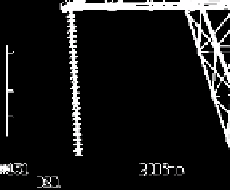Graphics Reference
In-Depth Information
(a) (b)
Fig. 14.
Candidate points of each connected region in Im 3. (a) Candidate points of region 1.
(b) The detected orientation angles of all insulators.
3.3
The Comparison of Existing Orientation Angle Detection Methods and
Proposed Method
In method 1 [16], rotate the target image to the largest of its horizontal projection, and
then the rotational angle is defined as the orientation angle of target. But the obtained
optimum tilt angle is an optimization procedure which needs multiple projections to
approximate to that leads to a large calculation. In method 2, the orientation of target
would be considered as the main direction when it has the maximum number of pix-
els, but it is easily susceptible by noises. In method 3, radon transform [17] in the
range of
[
°
2-
is implemented on the target image. Then the accumulative total
of absolute value of difference of the results is calculated, respectively. The angle of
the radon transform corresponding to the maximal accumulative total is confirmed as
a skew angle of target image. But it may be not able to obtain the accurate tilt angle.
Method 2 affirms the orientation angle of target by Hough [18], but there is a contra-
diction between accuracy and computation complexity. The above methods are deal-
ing with target without background, and they may not meet the demand of orientation
angle detection of complex image.
This paper firstly rotates the original image from 0°to 60°at 10°intervals, and esti-
mates its rotation angle by the above four methods and proposed method to verify the
effectiveness of our method.
From the detection angle of method 1 in Table 1, the performance of method 1 is
reducing while the rotation angle is increasing. The horizontal projection is equal
when the two rotation angles of original image are symmetrical about horizontal di-
rection, and this method can not make correct judgment. Method 2 contains notable
error caused by noises. And compared with method 3 and 4, the detected angles of the
proposed method are closer to the correct value; the method 3 and 4 are susceptible to
noises and prone to be lost in local maxima, and the proposed method is robust by
noises which can produce high accuracy. In conclusion, the proposed method is more
approximate to the exact orientation angle and has higher accuracy within a limit of
allowable error.
°
20






















































































































Search WWH ::

Custom Search